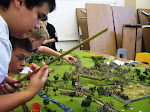Despite the crush of the holidays, I opted to put on a game of Regimental Fire and Fury for a few of my students. The battle was a fictional affair that takes place in the fall of 1862. Abner Doubleday's division has been given the task of securing passage over a bridge held by D.H. Hill's Confederates. The Yankees held a numerical advantage, four brigades versus three, and surpassed the men in butternut in artillery as well, nine guns to six.
The Union players were aggressive, knowing that they only had a little time (two and a half hours of game time) to secure their objective. There were two player marshaling the forces of the northern cause. One took Phelps's and Gibbons' brigades plus a battery to attack the rebel right flank. The other commander pressed on with Patrick's brigade and Hoffman's in support to engage the Confederate left.
The first blood was drawn by the skirmishers of Phelps' brigade as they pressed in on Ripley's unit. The young brigadier playing the part of Ripley responded with vigor. In the end, it proved to be excessive. Skirmish lines blazed away and a considerable number of 10s were rolled, meaning that units ran low on ammunition quickly. Rolls were taken to see if commanders were hit, but the good Lord seemed to be watching over them this day as bullets continually missed their mark.
Ripley's men were itching for a fight, so they charged out from their hasty works. One unit was stopped cold by intense musketry and another didn't roll high enough to close with a battery of Union artillery. Over the next two turns both of these regiments were torn to pieces by concentrated rifle and cannon fire. To make matters worse, Gibbons' elite brigade came up to add its strength. By the end of the game, Ripley's regiments were all spent and having to fall back. The one bright spot came when a regiment of zouaves attempted a charge and ended up being broken due to a very unlucky dice roll. Other than that, the rebel right flank was pretty much destroyed.
On the other flank, Collquit's brigade also decided to charge as opposed to being decimated by cannon fire and musketry. Most of the units were armed with smooth bore muskets, and so they were at a disadvantage in a firefight. Collquit's charge drove back Patrick's brigade, but in the meantime, Hoffaman's men were able to form a second line supported by a battery of artillery. As the game ended, the rebs inflicted losses on the yanks, but were in turn battered themselves.
Anderson's brigade stayed put in positions near the bridge. Though they hadn't suffered any casualties, they would have been hard pressed to hold out against two fresh, veteran Union brigades. Additionally, despite being on the defensive, the rebels lost many more men than the attacking yankees did. The young Confederate commander's aggressiveness had a large price tag.
 |
| The bridge was the objective in this game |
 |
| This is Ripley's brigade, holding the right flank |
 |
| Anderson's brigade guarded the bridge |
 |
| This is Phelps' brigade advancing towards Ripley. |
 |
| Collquit's brigade, holding the rebel left |
 |
| Ripley's men are mowed down by cannister |
 |
| This is Patrick's brigade advancing on Collquit |
 |
| Two of the young commanders. They picked up the rules fairly quickly. |
 |
| Collquit's brigade's high water mark. Patrick's men have been forced back, but Hoffman's brigade is in position to stem the tide. |
 |
| A Union battery deployed for action |
 |
| A closer shot of Anderson's brigade |
 |
| The aftermath of Ripley's ill fated attack. |














Looks like a lot if fun, luck lads! I wish I had the chance to play with armies like this when I was a kid. Still as John C Reilly says in step brothers "even better, we get to play with them when we are 40".
ReplyDeletecheers
Paul
Or in my case, close to 60!
DeleteWonderful looking game.
ReplyDelete